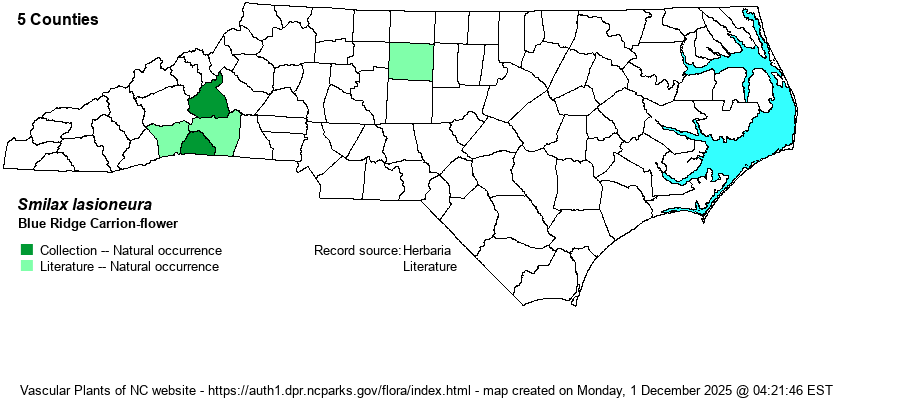| Author | Hooker | |
| Distribution | A very poorly known species in its range, as it involves recent splitting of former species. Very spottily distributed in the Mountains and Piedmont, with records known only from the southern Blue Ridge Escarpment area (Henderson, McDowell, Polk, and Rutherford counties) and an historical record far to the east in Guilford County (NC NHP database records).
A wide-ranging species, from Ontario and MT south to western NC, the FL Panhandle, OK, and CO; a questionable record from VA (data from Weakley 2018).
| |
| Abundance | Certainly easily overlooked (as S. herbacea or S. pulverulenta), and under-reported. Currently considered as rare in the southwestern corner of the Piedmont and adjacent Mountains, and casual farther east. The NC NHP database lists 10 records, with several of them historical; most extant ones are recent finds from the South Mountains region in southern McDowell and northern Rutherford counties (on private lands). This is an NC Significantly Rare species. As this is a mostly Midwestern and otherwise wide-ranging species, NatureServe ranks this as G5; it is clearly numerous west of the Appalachians but is also clearly rare within them and in the Atlantic Seaboard states, despite a misleading common name. | |
| Habitat | This species seems to require high pH soils in NC, though primarily in oak-hickory forests or other dry to mesic forests as opposed to rich cove forests and floodplains. More observations/records are needed to fully understand the habitats in NC. | |
| Phenology | Blooms in April and May, and fruits in August and September. | |
| Identification | This is a split from the older and more inclusive S. herbacea, and it is similar to both the split species (sensu strictu) and S. pulverulenta. Like them, it grows to 2-3 feet long and leans or somewhat twines over other vegetation, and has alternate leaves. The leaves are ovate and have convex margins, as the other two, but this species has pubescence on the leaf undersides, at least along the veins (as does S. pulverulenta). Smilax lasioneura has the leaves pale green with a dull surface below; S. pulverulenta has bright green and shiny leaf undersides (Weakley 2018). The first also has glaucous, dark blue fruit; S. pulverulenta has black fruit that are not glaucous. There are a few other differences with the inflorescences and their stalks; see Weakley (2018) for such characters. Thus, for most folks, you may have to collect a stem and key it out later, or else have a smartphone with an identification app with you, to key the Smilax in the field. | |
| Taxonomic Comments | This is a fairly recent split from S. herbacea, but this taxon does not appear in RAB (1968). The fact that BONAP does not have a map for this taxon suggests that it is not widely accepted as a good species, or else there is simply too much uncertainty as to what specimens in herbaria are really this species and not S. pulverulenta or S. herbacea.
| |
| Other Common Name(s) | Common Carrion-flower (also used for S. herbacea) | |
| State Rank | S1 [S1?] | |
| Global Rank | G5 | |
| State Status | SR-P | |
| US Status | | |
| USACE-agcp | | |
| USACE-emp | | |

